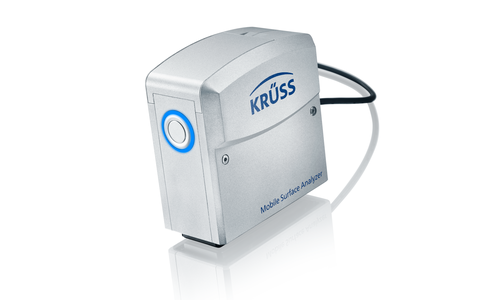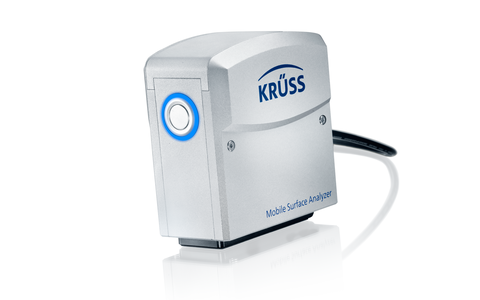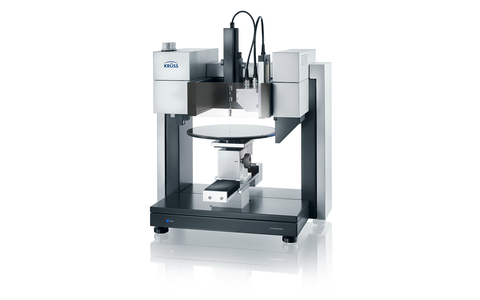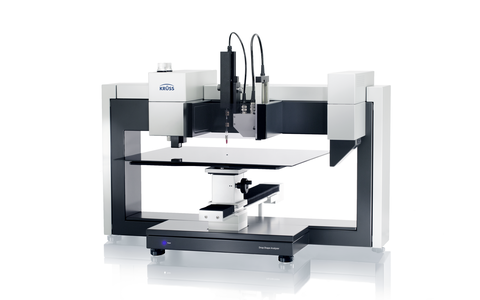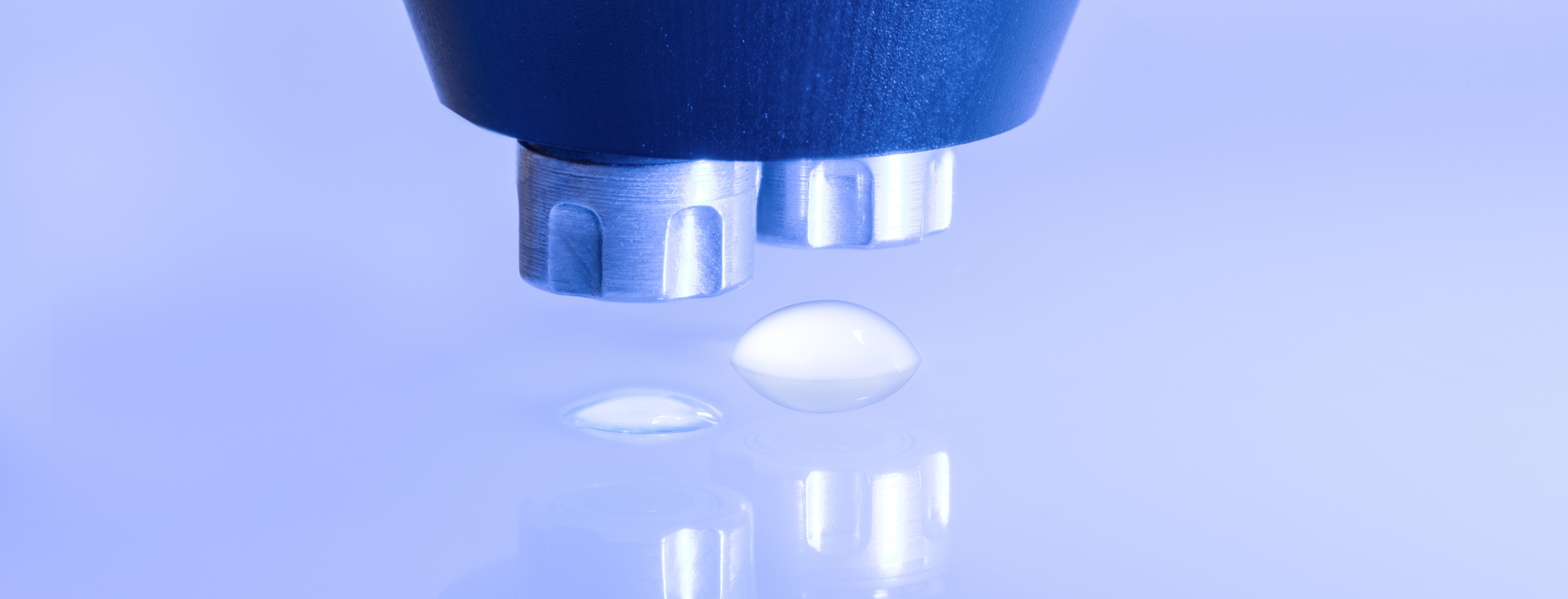
Replacing the solid needle by a liquid one when measuring static contact angles
Comparison of the traditional solid needle dosing system and a novel pressure-based dosing system, a so-called Liquid Needle
Needle-deposition of sessile drops is a well-established method in contact angle analysis. However, customers regularly report user-dependent variations of contact angles as well as problems to deposit liquid drops on super-hydrophobic surfaces, or they demand higher deposition speeds. Here we present a new technique for drop deposition that is based on a Liquid Needle in contrast to a solid one. Further, we highlight the main findings of a scientific study published in the Journal of Colloid and Polymer Science (DOI 10.1007/s00396-015-3823-1) [1] where we thoroughly compared both techniques using 14 different sample surfaces. We show that the resulting contact angles of droplets dosed by either technique are identical. In addition, we explain how potential pitfalls of needle-dosing – when not carried out very carefully – are eliminated by the alternative Liquid Needle dosing technique.
Background
Contact angle measurements are widely used as a fundamental technique to investigate and describe surface and interface phenomena. In multiple fields of industry such measurements are carried out to optimize adhesion of coatings and understand wetting of liquids on solid substrates, or as part of quality control processes to check surface activation as well as surface cleaning steps.
The basic way how liquid drops are deposited onto solid sample surfaces has not changed ever since optical contact angle measurements had been established: A drop of liquid is generated at the tip of a needle, which is then carefully brought in contact with and subsequently transferred to the sample surface.
This way of dosing runs into limitations when super- hydrophobic surfaces or fast deposition speeds are an issue [1]. In addition, erroneous results may be obtained if the drop deposition is not performed very carefully. Variations in measured contact angles between different users can occur (see Fig. 1), while it is of high interest to render the experiment as user-independent as possible.
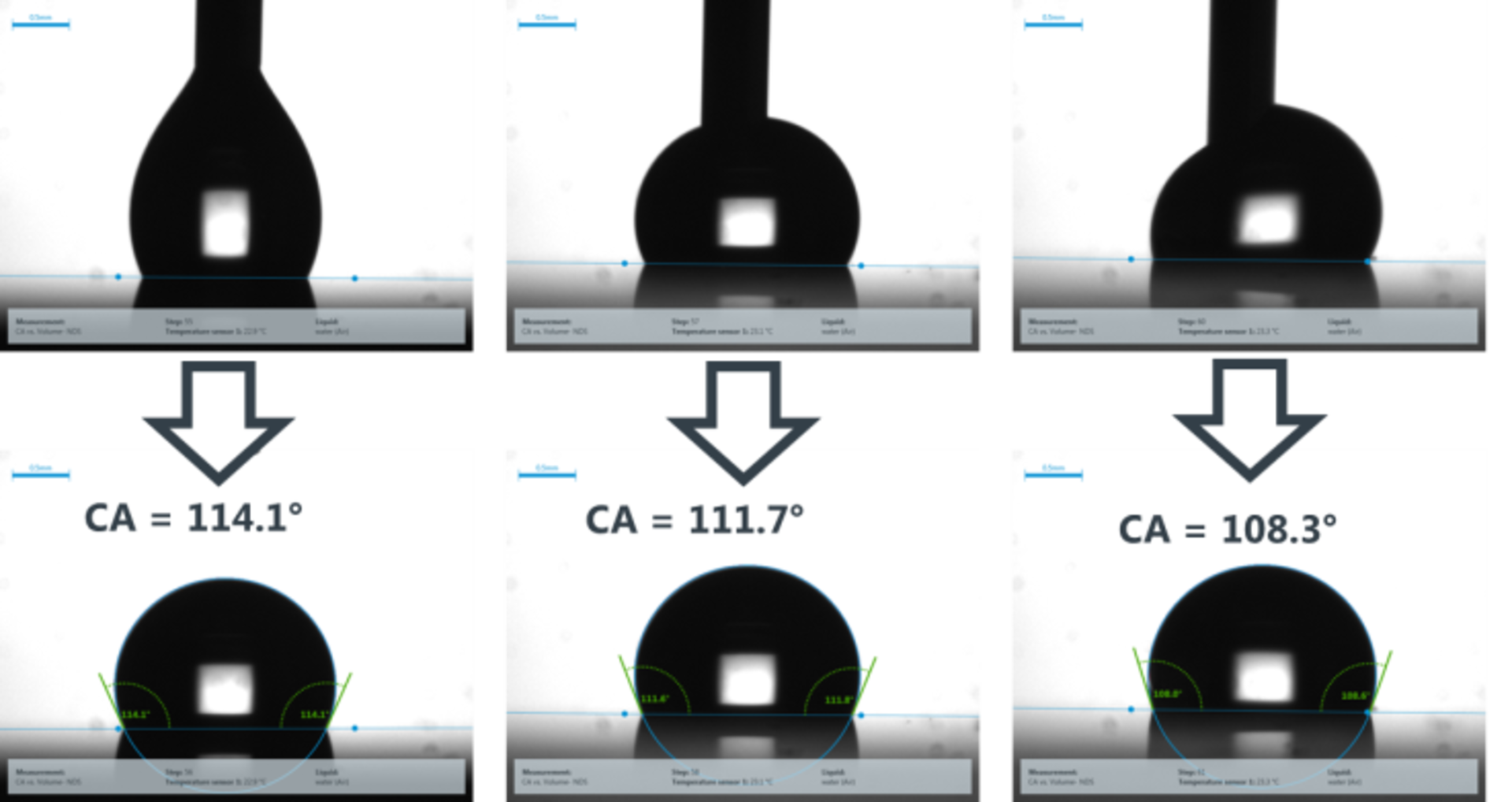
To avoid these potential pitfalls, we have developed and implemented an alternative pressure-based dosing technique which builds the drop with a well-defined liquid jet (referred to as Liquid Needle) directly on the substrate (see Fig. 2). The Liquid Needle is optimized to deposit a drop as carefully as possible, while other needle-less techniques reported in literature introduce a considerable amount of kinetic energy into the drop, causing the drop to “splash” onto the surface. Contact angles obtained from e. g. falling drops therefore describe the result of a de-wetting process and are most often significantly smaller than contact angles obtained from needle dosing systems.

Experimental part
Static contact angle measurements were performed with a Drop Shape Analyzer – DSA100 and evaluated using the software ADVANCE. To assure a repeatable and user-independent drop deposition, an automatic procedure was defined in the software for both dosing systems.
Each different sample was analyzed with the same light settings and fitting algorithms. Measurements were carried out under ambient conditions.
Contact angle measurements were carried out on 14 very different samples:
- Hydrophilic surfaces (glass, smartphone display)
- Hydrophobic surfaces (P2i super-hydrophobic paper, polydimethylsiloxane PDMS)
- Technical polymers (polyethylene PE, polypropylene PP, polyamide PA6)
- Silicon wafers (wafer 1, wafer 2)
- Self-assembled monolayers on SiO2 (dichlorodimethylsilane DDMS, aminopropyltrimethoxysilane APTMS)
- Rough surfaces (DDMS-silanized sand papers of grain sizes 500, 1000, and 1500)
With the samples we covered a broad range of water contact angles from very low (smartphone display) to very high (P2i hydrophobic paper) and also different degrees of surface homogeneity (from homogeneous SAMs to sand paper samples with a macroscopic surface roughness).
All samples were cleaned and dried prior to the measurements. A detailed description of the experimental setup and the sample preparation can be found in the cited reference [1].
Results
The results of contact angle measurements on the 14 samples are shown in Fig. 3a and Fig. 3b, with water and diiodomethane as test liquids, respectively.


For all samples, both ways of dosing give comparable contact angles and small standard deviations.
Concerning the effect of the needle deposition on the contact angle on surfaces with a high contact angle hysteresis such as PDMS (see fig. 1), one can conclude that the liquid needle is an even more careful way of drop deposition than the solid needle, as the resulting contact angle on PDMS is even higher for PDS compared to NDS [1].
For diiodomethane as a second, non-polar test liquid we also obtained well-comparable contact angles for both dosing types (Fig. 3b). For glass, the contact angles of 1 µL drops dosed by PDS were significantly smaller than those dosed by NDS. This can be explained by the higher density of diiodomethane compared to water, which brings more kinetic energy into the drop [1]. A simple way to rule out the influence of this additional kinetic energy on contact angles is to dose a recommended drop volume of 2 to 2.5 µL instead of 1 µL. Then the kinetic energy of the liquid jet dissipates over a larger drop volume and both dosing systems yield identical contact angles (dark blue columns).
On super-hydrophobic surfaces like the P2i paper, it was not possible to transfer drops of volumes as small as 3 µL to the surface with the NDS. This is due to the very low surface free energy (very low adhesive interactions) of this sample. Therefore drops of 6 µL had to be used for NDS (Fig. 3a, green bar). In contrast, drops of virtually any volume can be dosed on such samples with the PDS. This is something we consider a strong point of the PDS.
The fully automatic measurement of 20 drops using the NDS and the PDS usually took around 220 s and 54 s, respectively, which makes the PDS a much faster technique for analyzing a surface.
Summary
We present a new way of dosing called Liquid Needle which is based on a liquid jet building up a drop on a solid substrate for static optical contact angle measurements. This new technique is compared with the classical technique of using a solid needle for dosing in a study of two common test liquids on 14 very different solid substrates.
The obtained contact angles are basically identical for both drop deposition methods, while the Liquid Needle method offers some advantages over the classical method: experiments are much faster and drop deposition on super-hydrophobic surfaces is easily possible.
Most importantly, any possible influence by the user and resulting issues with reproducibility of results are virtually ruled out for this novel drop deposition technique. This will help to further increase the comparability of contact angles measured by various groups. In conclusion, we believe that using the Liquid Needle is advantageous for many contact angle studies and may become another standard method in optical contact angle measurements.
A detailed description of all experimental conditions and discussion of all results can be found in the article published in the Journal of Colloid and Polymer Science [1].
Bibliography
[1] M. Jin, R. Sanedrin, D. Frese, C. Scheithauer and T. Willers, “Replacing the solid needle by a liquid one when measuring static and advancing contact angles”, Colloid Polym. Sci. 294(4), 657-665, DOI 10.1007/s00396-015-3823-1 (2016).
